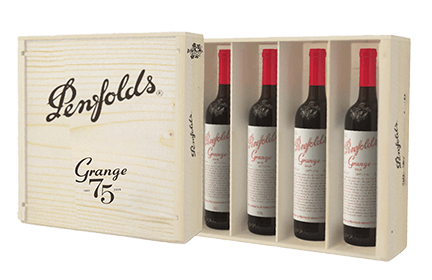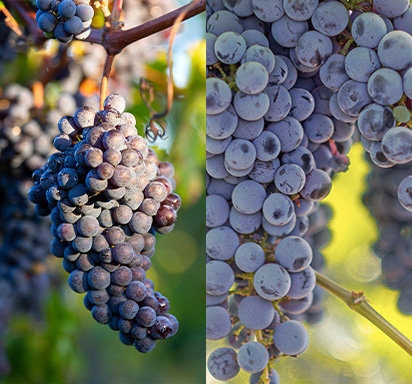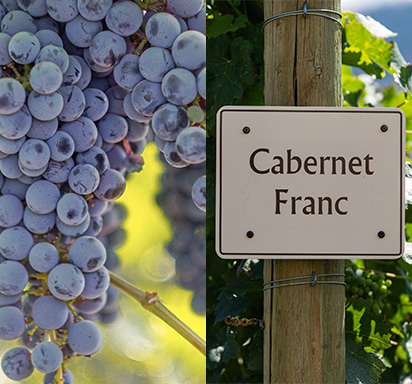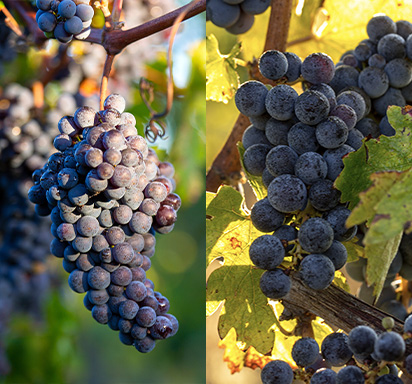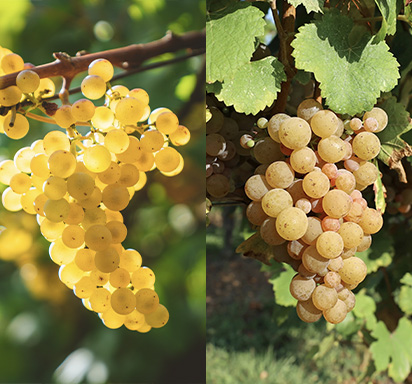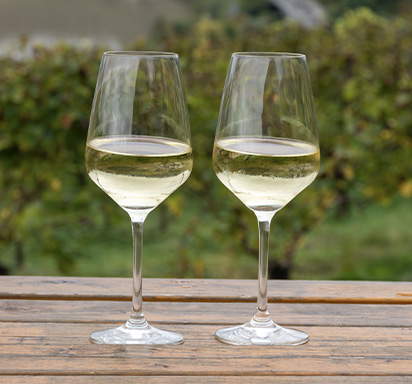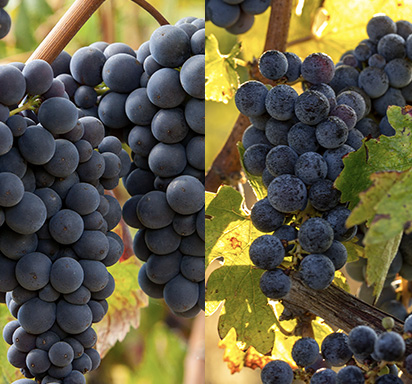Chardonnay | A White Grape Variety Conquers the World

What stylistic differences distinguish a Chablis from a Meursault? Which Californian wine regions are known for their world-class Chardonnays? And what culinary pairings are suitable for this famous white wine variety?
What stylistically distinguishes a Chablis from a Meursault? Which Californian wine regions are known for their world-class Chardonnays? And for which culinary combinations is the famous white wine variety suitable?
Chardonnay: A Famous and Versatile All-Rounder
Chablis Grand Cru, Puligny-Montrachet, Meursault, Corton-Charlemagne... These magnificent Burgundy white wines, celebrated by connoisseurs and critics alike, are among the most famous and sought-after Chardonnay wines in the world. Although the grape is mostly processed as a single variety, it is also found in blends, for example, in Champagne, in southern France, or in the so-called New World. For instance, in South Africa, it is sometimes blended with Colombard, in Australia with Semillon, or in Languedoc with Viognier. It is also used in the production of some fine sweet wines, such as in Austria's Burgenland.
In simplified terms: from sparkling fine wines to inconic white wine, from rich and creamy to steely and mineral, from bone dry to sweet – Chardonnay can do it all. Let's take a closer look at the different growing regions and wine profiles!
A Brief Insight into Soil, Climate, and Style
Soil and Climate
The white grape variety adapts to both cold and warm climatic conditions, and its character is strongly influenced by the wine region, climate, and production. Therefore, it is difficult to draw a general profile regarding the taste of the wines it produces. However, the grape achieves its best results in rather cool regions.
Taste and Profile
Complex aromas are often recognizable, reminiscent of fresh citrus notes, stone fruits (peach and apricot), or exotic fruit notes like pineapple, mango, and passion fruit. Pastry, butter, or brioche notes, as well as roasted, coconut, or even vanilla notes, can also emerge, especially when oak barrels are used in aging – it is one of the few white wine varieties that can tolerate aging in wooden barrels. Malolactic fermentation, where malic acid is converted into lactic acid, takes place in the barrels. This softens the acidity and gives the white wine a creamy and tasty texture, as found in the top Burgundy appellation Meursault.
Aging Potential
Most Chardonnay wines can be wonderfully enjoyed in their youth. However, the Grand Crus from Burgundy or California are more long-lasting: these noble wines have a very promising aging capacity and develop their full potential over time.
From Burgundy to Napa Valley: The Most Renowned Chardonnay Growing Regions
Burgundy: The White Wine Paradise Par Excellence
It is impossible to dwell on this grape variety without mentioning northern Burgundy, in France. From the north to the south of the region, the vine thrives there and can elegantly and accurately reveal the identity of each terroir, showcasing a different expression that sometimes only differs by a few parcels or even rows, making it hard to imagine that it is the same grape variety. This diversity is what makes Burgundy white wines so special. The grape has been cultivated there for centuries and accounts for more than 51% of the region's vineyard area. Nevertheless, the name of the grape variety is rarely mentioned on the bottle label. In Burgundy, the respective Chardonnay style is described by the appellations.
Chablis: A Unique Style in Burgundy
Let's start with northern Burgundy, with the wine-growing region Chablis located in the Yonne department. In this area characterized by a particularly harsh climate with cold winters and dry hot summers, the variety produces dry white wines with fresh citrus notes and smoky mineral notes with aromas of flint. On the palate, a lively acidity and a salty mineral expression come to the fore, linked to the terroir: Chablis vineyards are situated on marl and limestone soils from the Kimmeridgian, which have a special minerality due to numerous small fossilized comma-shaped oysters. Unlike the other Burgundian appellations further south, Chablis is not aged in oak barrels, making the appellation's wines unmistakable within Burgundy.
The Top Appellations of the Côte de Beaune (Côte d'Or)
The moderate climate of the Côte d'Or offers ideal conditions for Chardonnay cultivation and boasts exceptional wine-growing regions. Especially in Côte de Beaune and Hautes Côtes de Beaune, some of the greatest Chardonnay wines are produced. Here, world-class quality is crafted!
Meursault
The Meursault appellation produces white wines with a golden-green color, which varies more or less depending on the wine's age. The nose reveals a complex range of aromas, developing notes of citrus fruits, honey, roasted nuts, or floral aromas. On the palate, the wine impresses with richness, density, and gourmet expression. Between creaminess and freshness, power and balance, a typical Meursault has a long and persistent finish. These are undeniably top-quality wines with long aging potential.
Puligny-Montrachet
The Puligny-Montrachet appellation produces very fine Chardonnay white wines. The wines show a shimmering gold color with green reflections that develop over time. It reveals a wide range of aromas, with notes of ripe fruits, marzipan, and fresh notes of green apple. Milk, butter, and pastry notes are typical of the appellation, as well as the mineral notes of flint. On the palate, Puligny-Montrachet shows great finesse, complexity, and beautiful aromatic purity.
Corton
In Corton on the Montagne de Corton, elegant and round Chardonnay wines are produced, presented in a pale gold color with green reflections. The aromatic bouquet develops into sweet pastry notes reminiscent of buttered brioche, baked apples, and honey while also displaying a lovely minerality. The aging potential is 4 to 10 years.
Pouilly-Fuissé
Further south in Burgundy, in the Mâconnais, lies the Pouilly-Fuisse appellation. Here, Chardonnay white wines are mostly not aged in oak barrels. Pouilly-Fuisse is characterized by notes of ripe fruits and tropical fruits, while the palate offers a beautiful density without losing freshness.
California – The Other Star of Chardonnay
Some of the greatest Chardonnay wines can be found in California's wine regions. Briefly recalling the famous 1976 Judgment of Paris: At that time, the most renowned red wines of the Grand Crus Classes from Bordeaux and the greatest white wines from Burgundy were compared with Californian wines, and the result caused an uproar among tasters and critics worldwide: In the white wines, the 1973 Chardonnay from Californian Chateau Montelena took first place, ahead of a 1973 Meursault 1er Cru Charmes from Domaine Roulot. Of the ten best wines in the ranking, six were of Californian origin, including wineries like Chalone Vineyard and Spring Mountain Vineyard.
The Main Californian Wine Regions
In recent decades, the grape has established itself as one of the emblematic varieties of the region. The best wines are grown in the more moderate and cooler areas near the Pacific Ocean. Premium Chardonnays can be found in Sonoma, Carneros, and Russian River.
Sonoma
Chardonnay from Sonoma Valley is aged in French and sometimes American oak barrels and is characterized by its aromatic bouquet with notes of ripe fruits, yellow peach, and lemon, complemented by buttery, milky, and vanilla notes. The powerful taste unfolds a dense, gourmand matter with a creamy texture. In recent years, Californian winemakers have focused on a fresher style with vibrant acidity due to changing consumer preferences. The berries are harvested when the sugar concentration is still relatively low and the acidity levels are high. Three areas particularly stand out: Fort Ross-Seaview, Petaluma Gap, and West Sonoma Coast.
Los Carneros
The Los Carneros or Carneros area, considered one of the world's best regions for the royal grape, lies between the two most famous Californian wine regions: Napa in the east and Sonoma in the west. Carneros is one of the oldest wine-growing regions in California, with the first vines planted here as early as 1830. Carneros, less than 50 km from the Pacific Ocean, has a cool, windy microclimate with morning fog in spring and autumn. Due to the climate, Carneros – like Burgundy – is also famous for producing fine Pinot Noir wines. Chardonnay from Carneros stands out for its elegance and freshness, with lively acidity and fresh stone fruit aromas.
Russian River
The Russian River Valley is also considered one of the best Chardonnay regions. The growing area is not far from the Pacific Ocean and offers a wide variety of microclimates. The cool ocean fog plays a crucial role in developing the aromas and high acidity of the grapes. The wine is characterized by fresh lemon and lime aromas, green apple notes, and an energetic palate with vibrant acidity.
Australia: Focus on Key Growing Areas
Within a few decades, the Chardonnay grape has established itself as THE white grape variety in Australia. The grape thrives particularly well in coastal regions, which benefit from oceanic influences and thereby gain freshness. Three zones can be distinguished:
Yarra Valley
In the Australian Yarra Valley, one finds great white wines from the popular variety. Here, the grape stands out with flavors of citrus fruits, lemons, fresh stone fruits, beautiful mineral, and floral notes. Chardonnay from Yarra Valley is predisposed for aging and can develop notes of figs over time. The taste is energetic, fruity, and mineral.
Adelaide Hills
The Adelaide Hills in southern Australia produce elegant Chardonnay wines with a beautiful structure and high acidity that can develop well in the cellar and have good aging potential.
Margaret River
In southwestern Australia lies Margaret River, the country's most famous wine-growing region. Some even believe that Chardonnay from Margaret River, due to its finesse and elegance, rivals its Burgundian counterpart. Margaret River Chardonnay is characterized by its great aromatic freshness, a perfect balance between acidity.
What is the difference between Chardonnay and Sauvignon Blanc?
Discover the key differences between Chardonnay & Sauvignon Blanc in our comprehensive guide on our blog. Explore their unique flavor profiles, origins, winemaking techniques, and perfect food pairings to elevate your white wine experience.
You may like
Explore the key differences between Malbec and Cabernet Sauvignon — from origins and taste profiles to food pairings and top producers — to discover which red wine suits your style best.
6/16/2025Explore the key differences between Cabernet Sauvignon and Cabernet Franc—from origins and flavor profiles to winemaking roles—so you can better choose and enjoy these iconic red grapes.
6/11/2025Malbec and Merlot are two beloved red wines, each with unique flavors, tannins,& origins. Malbec offers bold, dark fruit flavors with spice, while Merlot is smoother & more approachable. Learn their differences and food pairings.
4/1/2025Chardonnay and Pinot Grigio are two beloved white wines with distinct flavors. Explore their origins, flavor profiles, body, food pairings, and more to find out which wine suits your taste and occasion best.
3/27/2025A dry white wine has little to no residual sugar, offering crisp acidity & fresh flavors. Discover different types, tasting notes, & ideal food pairings for wines like Sauvignon Blanc, Chardonnay, & Pinot Grigio in this guide.
3/7/2025Pinot Noir and Merlot are two beloved red wines with distinct flavors, aging potential, and food pairings. Discover their key differences to help you choose the perfect bottle for any occasion.
3/5/2025



































